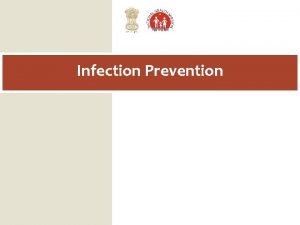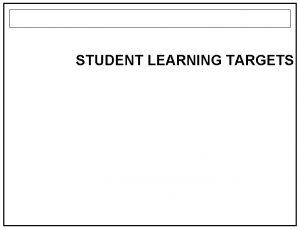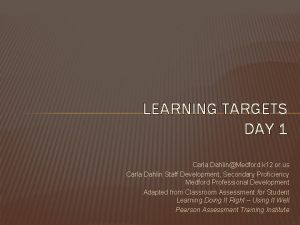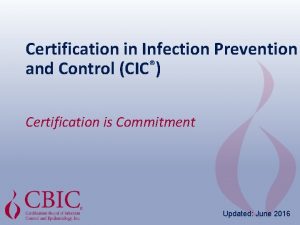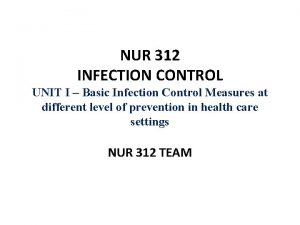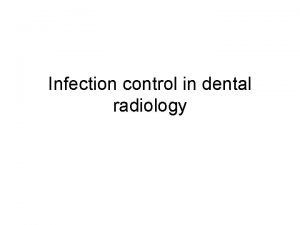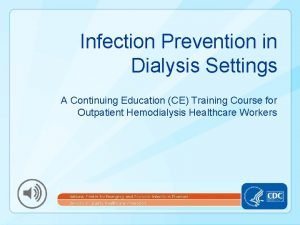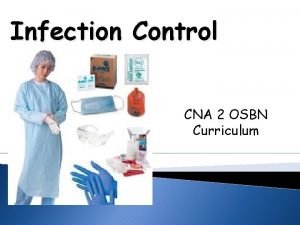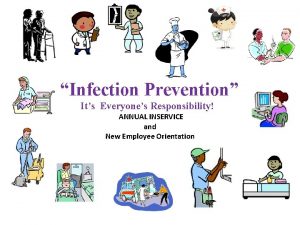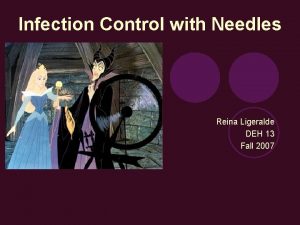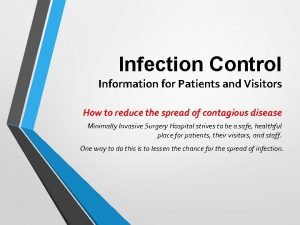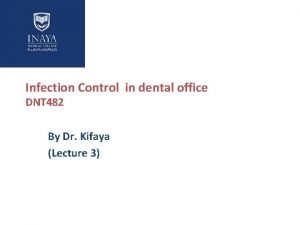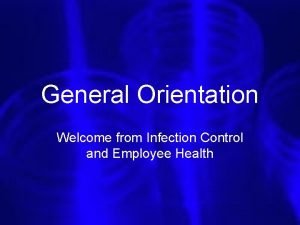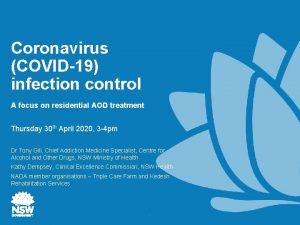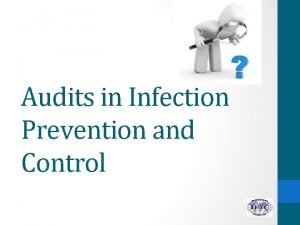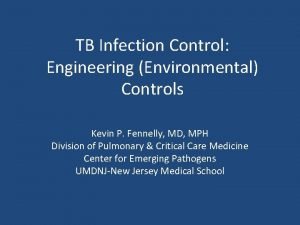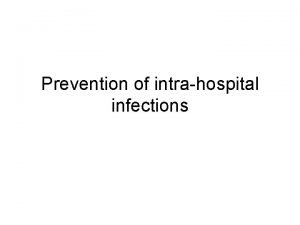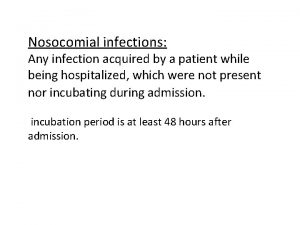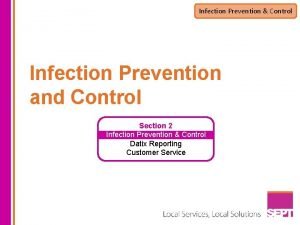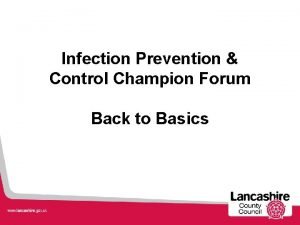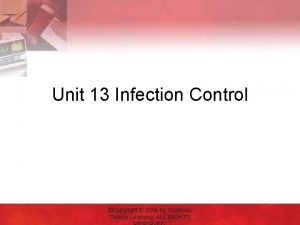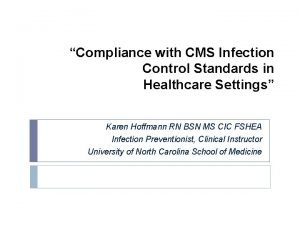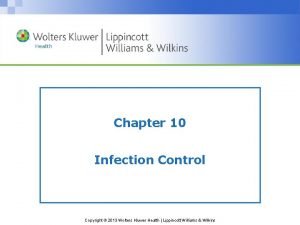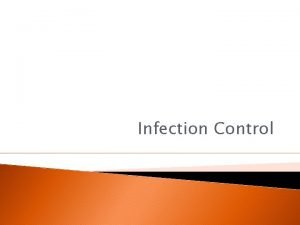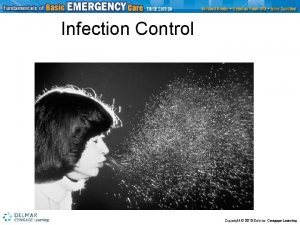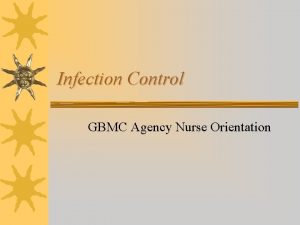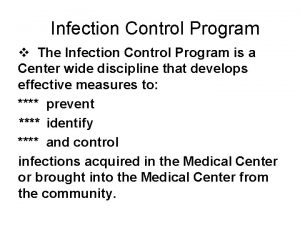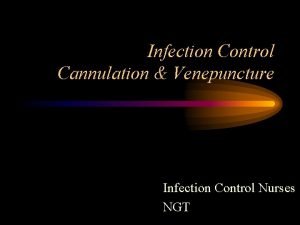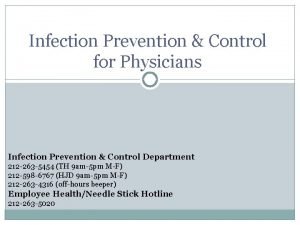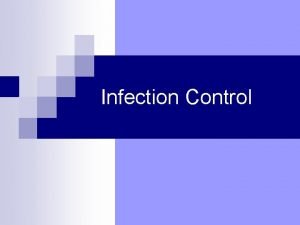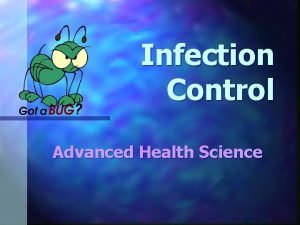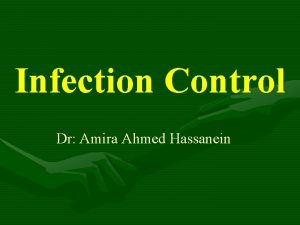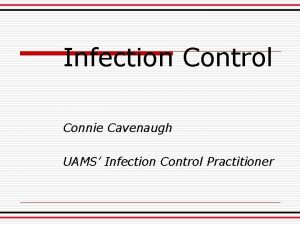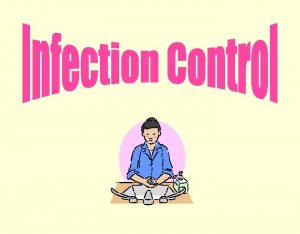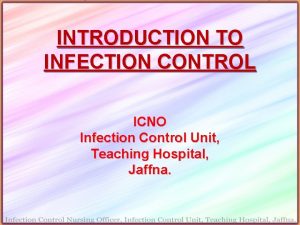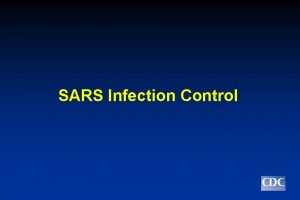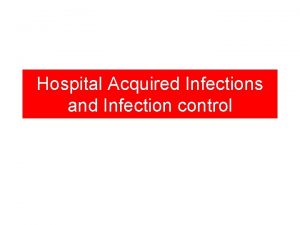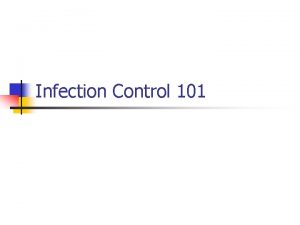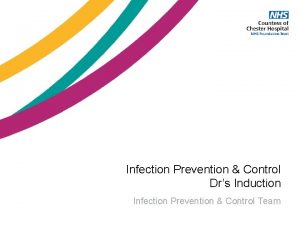Infection Control Learning Targets I can explain what












































- Slides: 44

Infection Control

Learning Targets • • • • • I can explain what a nosocomial infection is I can list all items of Personal protective equipment (PPE) and the situations they should be used I can identify things that should be reported and the proper person/place to report to I can explain standard precautions I can list the different types of transmission based precautions I can describe the role of OSHA and CDC in infection control I can give examples of blood borne pathogens/illnesses I can describe the chain of infection I can explain the difference in an epidemic and pandemic I can recognize biohazard symbol and what that means

Learning Skill Targets • I can correctly demonstrate proper handwashing • I can correctly demonstrate how to put on and take of PPE (gowns and gloves) • I can correctly remove contaminated gloves

Overview • • • Infectious diseases Causes of disease Prevention against disease Chain of Infection Types of PPE (personal protective equipment) • Legal obligations

Health Professionals • you must first protect yourselves, coworkers, and victims/patients • Understanding infectious disease transmission is vital – Allows prevention, protection, and management of potential infectious diseases outbreaks

CDC • Centers for Disease Control – Government Agency – Study disease prevention – developed standard precautions

OSHA • Occupational Safety and Health Administration – Government agency – Set guidelines for employers to keep workers in all settings safe – Blood Borne Pathogen Standard

OSHA • requires employers to develop a Bloodborne Pathogen Exposure Control Plan. • plan outlines protective practices to decrease the risk for hospital employees who might be exposed to bloodborne diseases. • requires high risk workplaces to supply gloves, Hep B vaccines or any other needed items to employees

Microorganism • AKA-- Microbe • A microorganism or microbe is an organism that is so small that it is microscopic • invisible to the naked eye • Types- Bacteria, Fungi, Viruses, Protozoa

Microorganisms • Pathogen-infectious agent that causes disease or illness to its host • Non pathogen-does not make you sick

Bloodborne pathogens • microorganisms that are present in human blood and some other body fluids (semen-spinal fluid) can cause disease in humans.

** • Blood Borne Pathogens include but are not limited to: – hepatitis B (HBV), – hepatitis C (HCV) and – human immunodeficiency virus (HIV).

Microorganisms • To be able to live………… • must survive the Chain of Infection • Are everywhere

Cycle of Transmission • Infectious agent/pathogen: the organism causing the infection • Reservoir-The host: the infected person or animal “carrying” the pathogen…. . Where it all begins • Portal of exit-how it leaves body • Transmission: how the pathogen is transferred from host to susceptible person or animal • Portal of Entry-how it enters body • The susceptible host: the potential future host

Glove Practice

Disease transmission – Contact transmission • Direct contact with infectious agent (objects) – Airborne transmission • Airborne particles settle or are inhaled – Vehicle transmission • Food or water carries infectious organism – Vector-borne transmission • Living creature harbors infectious organism


Standard precautions • a set of infection control practices used to prevent transmission of diseases • These are to be used when providing care to all individuals, whether or not they appear infectious or symptomatic. • Centers for Disease Control--recommends Standard Precautions for the care of all patients, regardless of their diagnosis or presumed infection status.

Standard Precautions apply to : • 1) blood • 2) all body fluids, secretions, and excretions, except sweat, regardless of whether or not they contain visible blood • 3) non-intact skin • 4) mucous membranes

Standard Precautions includes - hand washing - appropriate personal protective equipment - such as gloves, gowns, masks, whenever touching or exposure to patients' body fluids is anticipated.

• When should Health care workers wear gowns and gloves?

• When there is the CHANCE of contact with blood and body fluids


Now a step Further!

Transmission-Based Precautions • recommended to provide additional precautions beyond Standard precautions to interrupt transmission of pathogens.

Types of Transmission-Based Precautions • Airborne Precautions used for infections spread in small particles in the air such as chicken pox or TB (tuberculosis) • Droplet Precautions used for infections spread in large droplets by coughing, talking, or sneezing such as influenza. • Contact Precautions used for infections spread by skin to skin contact or contact with other surfaces



Break the Chain • https: //www. youtube. com/watch? v=_o 9 Sx. DFPUi. A

• If a nursing home resident is being transported from their hospital room to x -ray for test and they positive for Influenza……. . what should they have on before leaving the room.

Practice putting on your PPE!

Our Defense Against Diseases • Use standard/transmission-based precautions-PPE • Skin: first barrier to disease • Healthy body is best defense • Immunization/Vaccines • Antibodies • Know who is more at risk

Who is at risk? • Immune suppressed-Chemo and transplant patients • Very young and old • Chronic respiratory diseases

Hand Hygiene • Hand hygiene – Most simple and easiest way to prevent infection – Hand washing: part of routine patient care – Vigorous scrubbing for 15 -20 seconds washes away dead skin and bacteria

• ***THINK!! • Which person listed below would stand a better chance at defending against an infectious disease? • • A. Healthy 14 year old teen who plays tennis B. 76 year old female with lung cancer C. 5 year old with childhood asthma D. 5 Day old healthy baby boy

Disposal of waste • Potentially infectious materials are biohazard • Needle disposal: use sharps container • Accidental needle stick: largest risk for exposure to blood-borne diseases – Record in sharps injury log



Epidemic • occurs when an infectious disease spreads rapidly to many people

Pandemic • is an epidemic of infectious disease that has spread through human populations across a large region • multiple continents, or even worldwide

Legal Obligations • Reporting exposure – Health Care workers with exposure to infectious material must seek medical treatment and follow-up – Health Department • The Centers for Disease Control and Prevention (CDC) • Occupational Safety and Health Administration (OSHA)

Legal Obligations (cont’d. ) • Epidemiology – Used to prevent and control infectious diseases – Mandatory reporting of notifiable diseases is regulated at state level

Nosocomial Infection • Hospital acquired infection • One-third of nosocomial infections are considered preventable. The CDC estimates 2 million people in the United States are infected annually by hospital-acquired infections, resulting in 20, 000 deaths.

Conclusion • Importance of infection control cannot be overemphasized • Education of infectious disease is a necessity • Health Care Workers must know, understand, and continually practice infection control measures
 Learning objectives for infection control
Learning objectives for infection control Writing learning targets
Writing learning targets Learning targets
Learning targets Finish sketch crime scene
Finish sketch crime scene Reasoning learning targets examples
Reasoning learning targets examples Learning targets knowledge, reasoning, skill product
Learning targets knowledge, reasoning, skill product Learning targets helping students aim for understanding
Learning targets helping students aim for understanding Radiographic errors in dentistry ppt
Radiographic errors in dentistry ppt Tuberculocidal disinfectants milady
Tuberculocidal disinfectants milady Chapter 16 infection prevention and control
Chapter 16 infection prevention and control Chapter 16 infection control and standard precautions
Chapter 16 infection control and standard precautions Chapter 15:3 washing hands
Chapter 15:3 washing hands 15:4 observing standard precautions
15:4 observing standard precautions Cic infection control
Cic infection control Infection control meaning
Infection control meaning Darkroom infection control guidelines
Darkroom infection control guidelines Conclusion of infection
Conclusion of infection Cna infection control
Cna infection control Cbic recertification
Cbic recertification Infection control is everyone's responsibility
Infection control is everyone's responsibility Infection control
Infection control Nsw health
Nsw health Infection control information
Infection control information Root locus drawer
Root locus drawer Infection control orientation
Infection control orientation Infection control
Infection control Infection control audits
Infection control audits Environmental controls infection control
Environmental controls infection control Infection control isolation signs
Infection control isolation signs Infection control committee
Infection control committee Conclusion of infection control
Conclusion of infection control Rigid thinking examples
Rigid thinking examples Infection control champion
Infection control champion Unit 13 infection control
Unit 13 infection control Infection control surveyor worksheet
Infection control surveyor worksheet Chapter 10 infection control
Chapter 10 infection control If you can't measure it you can't control it
If you can't measure it you can't control it If you can't measure it you can't manage it
If you can't measure it you can't manage it Cuadro comparativo e-learning m-learning b-learning
Cuadro comparativo e-learning m-learning b-learning Objective of warehouse management
Objective of warehouse management Racial etiquette region
Racial etiquette region Brides magazine targets consumers who are in
Brides magazine targets consumers who are in Targets of change
Targets of change Smart targets gcse pe
Smart targets gcse pe Identifying market segments and targets chapter 9
Identifying market segments and targets chapter 9
